
The 1976 Friuli, Italy, Earthquake
May 23, 2011
Editor's Note: This month marks the 35th Anniversary of a magnitude 6.4 earthquake that occurred in the Friuli region of northeast Italy. AIR director of engineering analysis and research Dr. Paolo Bazzurro describes what happened that day, its aftermath, and its lasting effects.
Remembering the Event
Italy's Friuli region rolls down the lower slopes and foothills of the eastern European Alps into the flat flood plain of the River Tagliamento. To the east, today, is Slovenia, to the north, Austria. For centuries the foothills have been home to vineyards and small towns that in the 1960s had begun to make a transition from mostly farming to small-factory manufacturing. The historical capital of the region, Udine, lies to the south in the fertile Friuli plain (see Figure 1).
On 6 May, 1976, just before 9:00 pm, the ground began to shake. The shaking lasted less than 30 seconds, but was strong enough to cut power in Udine, about 25 kilometers south of the tremor's epicenter. This, as it quickly developed, was just a foreshock, having a magnitude of 4.5. There was a short pause, and then the mainshock struck—with a release of energy two orders of magnitude greater. This time the shaking lasted much longer. Instruments indicated a magnitude of 6.4.
The earthquake was felt strongly across most of northern Italy and as far south as the outskirts of Rome. It was also felt in several other countries: then-Yugoslavia, Austria, Czechoslovakia, Germany and Belgium. But the epicenter was just south of the the town of Gemona. It was a shallow event, estimated to have ruptured less than 20 kilometers below the surface. This is the most destructive kind of earthquake, as the energy it releases is closest to the human environment. Most of Gemona was destroyed.
So were the nearby towns of Buia, Colloredo, Forgaria, Maiano, Osoppo, Trasaghis and Venzone. In the morning, looking across Forgaria, a town of 4,000 near the Yugoslav border, a caribinieri officer described the damage as catastrophic. "Whole neighborhoods have been flattened," he reported. Later that day, in Gemona, one relief worker said, "We don't have enough coffins." Three hundred twenty-six people died in Gemona.
More than 500 aftershocks, coming in two waves, continued to jolt the region over the next six months. The second wave began with a cluster on 15 September, the strongest of which was estimated at ML 6.1, nearly as large as the mainshock in May. In the end, the area of greatest destruction—in which most structures were leveled—covered nearly 1,800 km2. The pre-quake population of this area was 103,662 people.
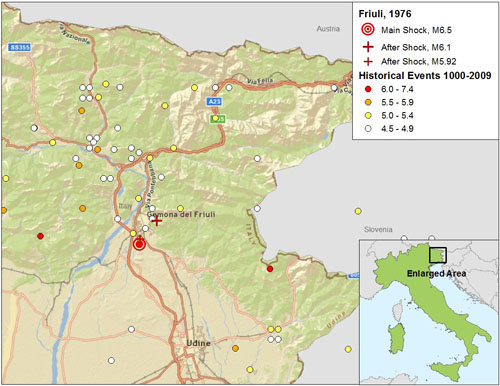
Forty-three thousand buildings—out of more than 70,000 inspected—were declared unusable, and thousands more were completely destroyed. Many schools, town halls, churches, and factories were ruined, along with Renaissance castles, other historical landmarks, and important art treasures. An estimated 15,000 workers lost their jobs because of destroyed or damaged factories. An area of nearly 5,000 km2, with a population of a half million people, was immediately affected.
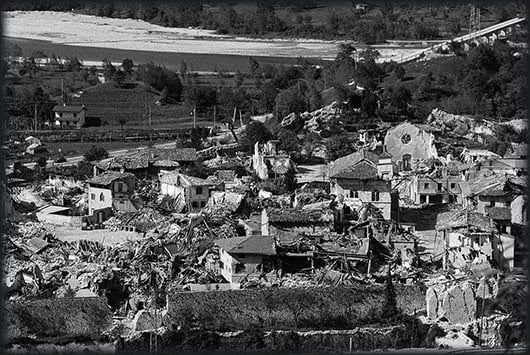
In the end, the 1976 Friuli earthquake and its aftershocks left 157,000 people homeless, injured 2,800, and killed nearly 1,000. Reported losses at the time came to 6,000 billion Italian lire.
The Aftermath
Most damage occurred in residential areas—to homes often more than 100 years old. These buildings were characterized by thick masonry walls made of large rocks and rubble stone held together with weak mortar. Floors were wooden and seldom effectively fastened to the walls. In the areas of greatest shaking (where the peak ground acceleration was 0.3 to 0.4), these buildings failed almost universally. Also, most houses in the area come right up against one another, and because additional rooms and/or floors were often added haphazardly over the years, the houses often had L-shaped or similar configurations that do not withstand shaking well.
A large number of churches, which similarly had thick stone walls and weak mortar, were also destroyed or severely damaged in the epicentral region. In many cases, only the rigid buttresses around an altar prevented their complete collapse.
Table 1 below shows the impact of the 1976 earthquake on the Friuli towns nearest the epicenter. The table indicates, first, the intensity of the event as measured on the Mercalli-Cancani-Sieberg Scale. Next, it lists three degrees of damage—from most severe ("D4-D5") to least severe ("D0-D1")—and the percentage of buildings within each category.
Table 1. Percent Damage in the Towns Most Affected by the 1976 Earthquake Sequence (Source: Dipartimento
| Town | Intensity | D4-D5 | D2-D3 | D0-D1 |
| Artegna | 9 | 50% | 45% | 5% |
| Bordano | 8.5 | 33% | 65% | 2% |
| Buia | 9 | 32% | 65% | 2% |
| Cavazzo Carnico | 7.5 | 5% | 17% | 78% |
| Clauzetto | 8 | 9% | 74% | 16% |
| Forgaria | 9.5 | 60% | 38% | 2% |
| Lusevera | 9 | 30% | 61% | 9% |
| Maiano | 8.5 | 30% | 53% | 17% |
| Montenars | 9.5 | 56% | 26% | 18% |
| Osoppo | 9 | 66% | 18% | 16% |
| Resia | 9 | 29% | 22% | 50% |
| San Daniele | 8 | 7% | 50% | 42% |
| Tarcento | 8 | 18% | 19% | 63% |
| Venzone | 9.5 | 65% | 34% | 1% |
| Vito D'asio | 8.5 | 38% | 62% | 0% |
Table 2 immediately below describes the damage categories ("D0" to "D5") used in Table 1. Color markers, or tags, indicate the level of safety of the damaged building, with red tags indicating "Unsafe: No Entry".
Table 2. Damage Levels Used in Table 1 (Source: adapted from the European Macroseismic Scale, EMS-98)
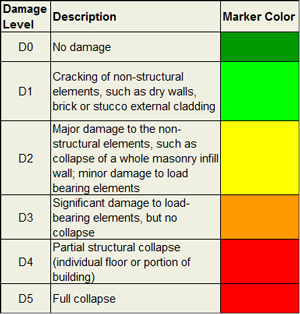
In general, houses that had been built more recently and had concrete floors and frames and brick-infill walls and partitions fared significantly better than older structures, even though they were not specifically designed to withstand the lateral loads imposed by strong earthquakes. High-rise buildings in the area were few, consisting of one ten-story hospital recently built in Gemona and many five- to eight-story condominiums (apartment buildings) located in or near Maiano. The hospital was severely damaged (part of it was later demolished), while several condominiums collapsed completely or were severely damaged. Many of this kind of building lacked (partially or completely) infill walls at the ground level, creating thereby both a strength and stiffness discontinuity (that is, a "soft" story).
Many industrial buildings also collapsed or were severely damaged. Most commonly, this was for lack of positive anchorage between their precast concrete roofs and the vertical elements of their building frames.
Recovery Efforts
Relief measures for Friuli began immediately. Because contingents of the Italian army had been stationed in the region at the time, two-thirds of the army, together with other NATO troops and Austrian and German relief organizations, were able to get to the disaster scene quickly. Railway cars and small mobile campers were brought into the ruined towns and villages to serve as emergency housing, while several tent camps also were set up, holding 16,000 tents. During the first month after the quake, aftershocks collapsed already weakened buildings, while others were made unsafe—and the number of people needing housing grew, exacerbated by emigrants from all over Europe who returned home upon news of the quake.
By the end of the summer, however, with substantial financial and other aid coming into the area, a semblance of normality was achieved and most workers were able to return to their factories.
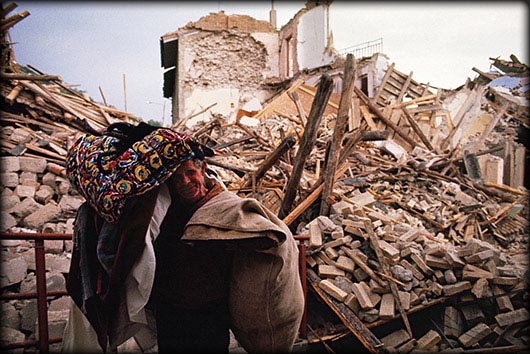
All that changed with the 15 September magnitude 6.1 aftershock. Many buildings collapsed that had just been restored, while many more were made newly or again unsafe. As this second stage of aftershocks began, many people became dispirited. Over 30,000 left the area. The number of homeless, which had decreased to 45,000, swelled again to more than 70,000.
Two years after the Friuli earthquake, in May of 1978, with the influx of considerable resources from the Italian Government, reconstruction of the region finally began in earnest. The effort included constructing a mix of new buildings both in a contemporary style and by restoring many older areas to their historical styles. Some entire towns were rebuilt in new—seismically safer—locations. Roughly a decade passed before the effort was substantively completed.
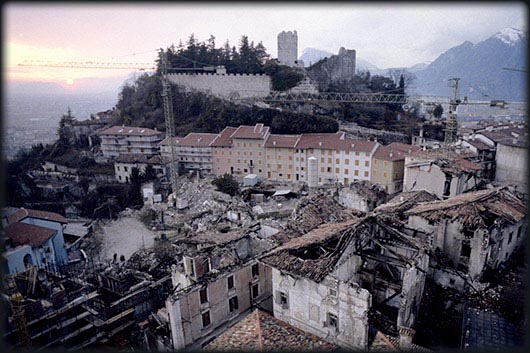
Changes Spurred by an Indignant Public
The initial response to the Friuli disaster was certainly rapid, but also not very effective. Over the ensuing months it came to be felt—in Friuli, but also throughout Italy—that the relief organizations were neither prepared nor sufficiently coordinated to sustain long-term operations effectively. However, for the first time, Italian television had the capability to bring the suffering and frustration of earthquake victims directly into peoples' homes. These live television reports also revealed the shortcomings of the relief efforts. The impact on public opinion was significant.
When another strong earthquake struck Italy just a few years later (in 1980 in Irpinia, near Naples), killing about 3,000 people—and relief efforts again did not go well—the public demanded change. As a result, the Dipartimento della Protezione Civile (Department of Civil Protection) was created and tasked with preparing, in peace time, for all aspects of earthquake (and other) emergencies. The new agency brought together a significant body of professionals who, in addition to managing disaster relief, instituted systematic, science-based post-earthquake damage surveys that have since become a world standard.
It was with the Friuli earthquake that a comprehensive damage survey was carried out with the main purpose of assessing the economic loss. The survey provided detailed criteria for determining which damaged buildings should be repaired and which should be demolished and rebuilt. It evaluated every building in the epicentral zone of the earthquake and all damaged buildings in other stricken areas. Basically, this same systematic and uniform approach, with a few improvements, has been applied ever since. This continuing effort (which to date has assessed the effects of all the major earthquakes in Italy since Friuli) has produced a comprehensive database of more than 500,000 inspected buildings.
The widespread destruction of masonry buildings that the earthquake surveys found initiated the development of technical documents that subsequently have been used to retrofit such buildings and to design new, more resilient ones.
Finally, the Friuli earthquake also encouraged the development of modern building codes in Italy and initiated changes in Italian efforts to identify distinct seismic zones throughout the country. Before Friuli, Italian seismic zoning consisted of little more than drawing bullseyes around the location of earlier earthquakes. After Friuli, the seismicity of all Italian municipalities was reclassified according to stated scientific principles informed by the entire history of past earthquakes rather than the last major event. In 1984 this effort led to the first systematic seismic classification based on historical catalogs.
Closing Comments
The legacy of the Friuli earthquake has been two-fold: it ended a "chasing the last earthquake" approach to seismic zoning; and it modernized earthquake emergency management and post-earthquake damage reconnaissance. These practices were embraced, refined, and expanded by the Dipartimento della Protezione Civile, which was created largely because of public reaction to the Friuli and Irpinia earthquakes.
Certainly the Friuli earthquake is a defining event in Italy's long seismic history, and one featured in the AIR Pan-European Earthquake Model which, with the release of Version 13.0 this summer, will expand from six countries to 30 across Europe and south to Israel. Using the updated model, AIR estimates that if the Friuli earthquake were to recur today, total (ground up) damage would exceed USD 22 billion. In regions such as northern Italy, characterized as it is by concentrations of high-value exposure, the AIR model can help companies prepare for the next large-scale event.

